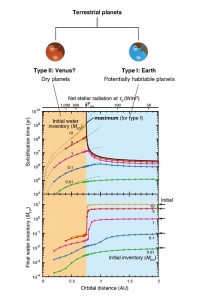Possible early divergence between Earth and Venus A new classification for terrestrial planets based on their early history

Venus has a similar size and bulk composition to the Earth, but lacks water. Based on planetary formation theory, terrestrial planets all start their lives in a molten state. It is commonly assumed that the time required for solidification depends on planetary mass, so that the Earth and Venus, as two comparably-sized planets, were thought to have undergone a similar evolution in the beginning of their history.

© Keiko Hamano, Two types of terrestrial planet. A strong transition in solidification time and final amount of water appears at orbital distance of ~0.75 AU from the host star. MEO means the current ocean mass on Earth.
K. Hamano, Y. Abe, and H. Genda at the Department of Earth and Planetary Science at the University of Tokyo’s Graduate School of Science constructed a magma-ocean-atmosphere coupled model and investigated the thermal history and volatile budget of early terrestrial planets. The researchers present a new theory that the early cooling history strongly depends on planetary orbital distance from the host star, so that terrestrial planets can be classified into two types based on early evolutionary path and characteristics. A type-I planet solidifies within several million years. If the planet acquires water during formation, most of this water is retained and forms the earliest oceans. By contrast, on a type-II planet, a magma ocean can be sustained for longer, even with a larger initial amount of water. Its duration could be as long as 100 Myr if the planet is formed together with a mass of water comparable to the total inventory of the modern Earth. Atmospheric escape desiccates type-II planets during the slow solidification process.
Whether a type-I or a type-II planet is formed around a star depends on a critical orbital distance, which ranges 0.6-0.8 AU under conditions in our solar system. Earth is categorized as type I, while Venus could be a representative of type-II planets. This study thus provides a new perspective on not only the differences between Earth and Venus, but also the origins of planetary diversity. Also, a long magma-ocean period for type II planets suggests that molten terrestrial planets might be more common in our galaxy than previously thought.
Department release/press release (Japanese)
Paper
Keiko Hamano, Yutaka Abe, Hidenori Genda.
“Emergence of two types of terrestrial planet on solidification of magma ocean,”
Nature vol.497, 607-610, doi: 10.1038/nature12163.
Article link
Links
Department of Earth and Planetary Science, Graduate School of Science






